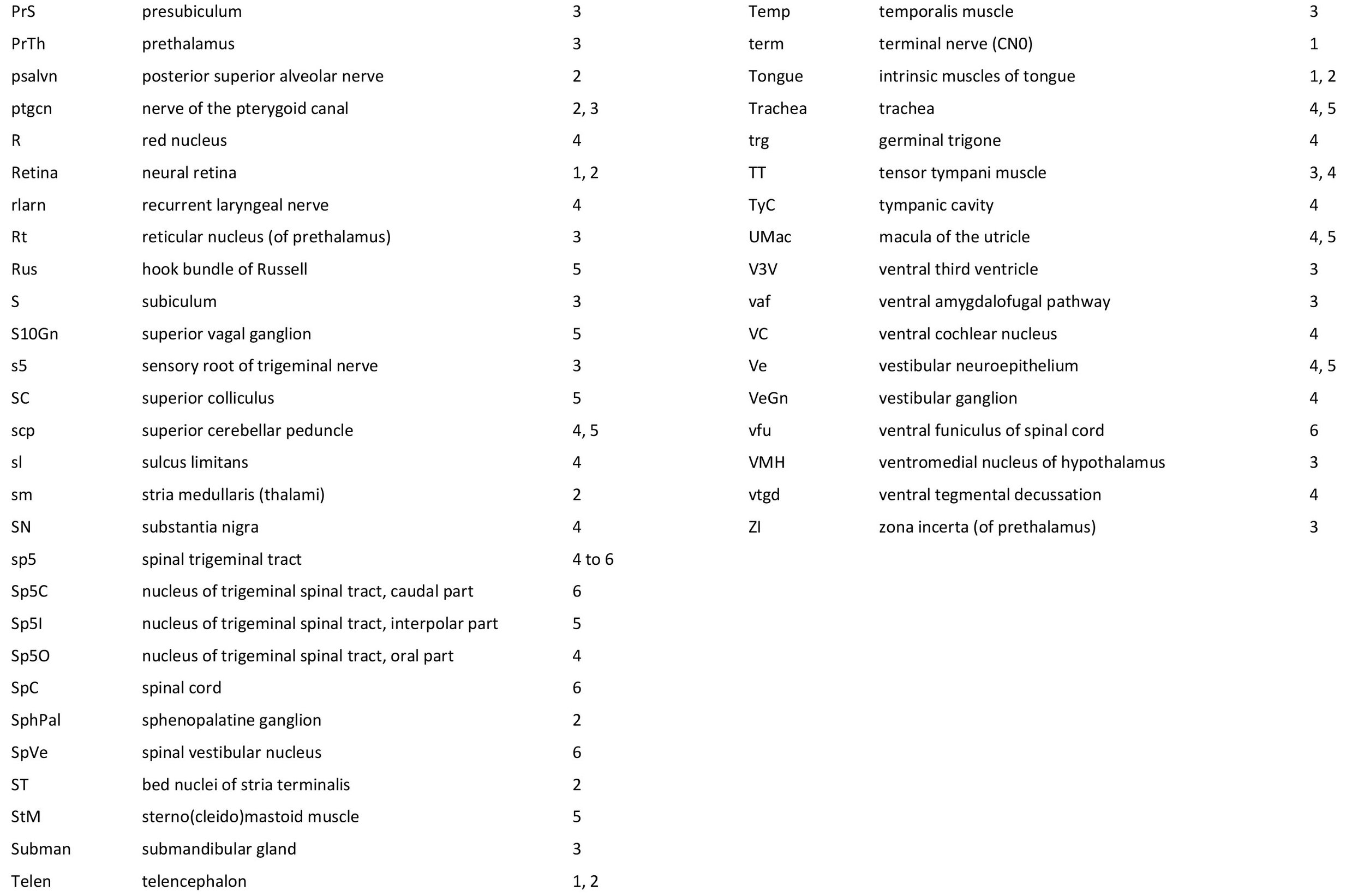GAP-43 Immunoreactivity in the Head of the P5 Tammar Wallaby (Notamacropus eugenii)
Introduction
The tammar wallaby (Notamacropus eugenii) is a small macropod originally found in Western and South Australia and on ten or more offshore islands. Please see the introduction for the P5 H&E atlas for details of tammar wallaby biology.
GAP-43 is a calmodulin binding phosphoprotein, which serves as a substrate for protein kinase C and is thought to play a critical role in axonal guidance (Meiri et al, 1986). It is found in growth cones within both the peripheral and central nervous system and is a useful marker for developing axons. In these plates it has been used to show the position and trajectories of growing axons in both cranial nerves and central nervous system pathways (Hassiotis et al, 2002).
Methods
The wallaby depicted in the series of colour plates was obtained from a breeding colony at the Australian National University (ANU) in the Australian Capital Territory (ACT). Some monochrome images of this specimen have been shown in a previous publication (Hassiotis et al., 2002).
All experimental procedures were approved by the Animal Ethics Experimentation Committee of the ANU, conform to NIH principles of laboratory animal care and were carried out according to the ethical guidelines of the National Health and Medical Research Council (Australia). The age of the pouch young animal was determined either directly by noting the elapsed time from the date of birth, which was designated P0, or from measurements of head-length and reference to a chart of head-lengths of animals of known age. This is accurate to within ±2 days.
The pouch-young tammar was anaesthetized by hypothermia and perfused with normal saline followed by Bouin’s fixative. The head was stored in 70% ethanol prior to embedding in paraffin and sectioning coronally at a thickness of 10 µm. The sections were mounted on subbed glass slides. Immunohistochemistry for GAP-43 was performed using an antibody from Sigma-Aldrich (see Hassiotis et al, 2002 for details), which recognises an epitope on both kinase C phosphorylated and dephosphorylated forms of GAP-43. The epitope is not affected by heat- denaturation and the antibody shows a wide range of interspecies cross-reactivity (from snake to human). After immunostaining, the slides were coverslipped with DePeX.
Each section was photographed with the aid of a Zeiss Axiophot photomicrographic system and a Canon EOS 400Dbody. Images were placed in Adobe Illustrator 2021 and delineated. Developmental regions (i.e. neuroepithelium) destined to give rise to adult structures have been denoted by the adult structure’s name with an asterisk (e.g. Cb* denotes the cerebellar developmental field of the rhombic lip).
The head is essentially bilaterally symmetrical, so only half the head has been depicted, with a 1 mm scale bar indicating the size of structures in the dehydrated tissue. A small finder cartoon has been provided in each plate to show the rostrocaudal position of the section. The distance from the rostral tip of the snout can be calculated by multiplying the section number by 10 µm.
References
Hassiotis M, Ashwell KW, Marotte LR, Lensing-Hohn S, Mai JK (2002) GAP-43 immunoreactivity in the brain of the developing and adult wallaby (Macropus eugenii). Anat Embryol 206, 97-118.
Meiri KF, Pfenninger KH, Willard MB (1986) Growth-associated protein GAP-43, a polypeptide that is induced when neurons extend axons, is a component of growth cones and corresponds to pp46, a major polypeptide of a subcellular fraction enriched in growth cones. Proc Natl Acad Sci USA 83, 3537-3541.
Figure 1 shows sections 213 and 243 through the head of a P5 tammar wallaby pouch young. These sections are respectively 2130 and 2430 µm from the tip of the snout.
Figure 2 shows sections 313 and 343 through the head of a P5 tammar wallaby pouch young. These sections are respectively 3130 and 3430 µm from the tip of the snout.
Figure 3 shows sections 413 and 443 through the head of a P5 tammar wallaby pouch young. These sections are respectively 4130 and 4430 µm from the tip of the snout.
Figure 4 shows sections 513 and 543 through the head of a P5 tammar wallaby pouch young. These sections are respectively 5130 and 5430 µm from the tip of the snout.
Figure 5 shows sections 613 and 643 through the head of a P5 tammar wallaby pouch young. These sections are respectively 6130 and 6430 µm from the tip of the snout.
Figure 6 shows sections 713 and 743 through the head of a P5 tammar wallaby pouch young. These sections are respectively 7130 and 7430 µm from the tip of the snout.











